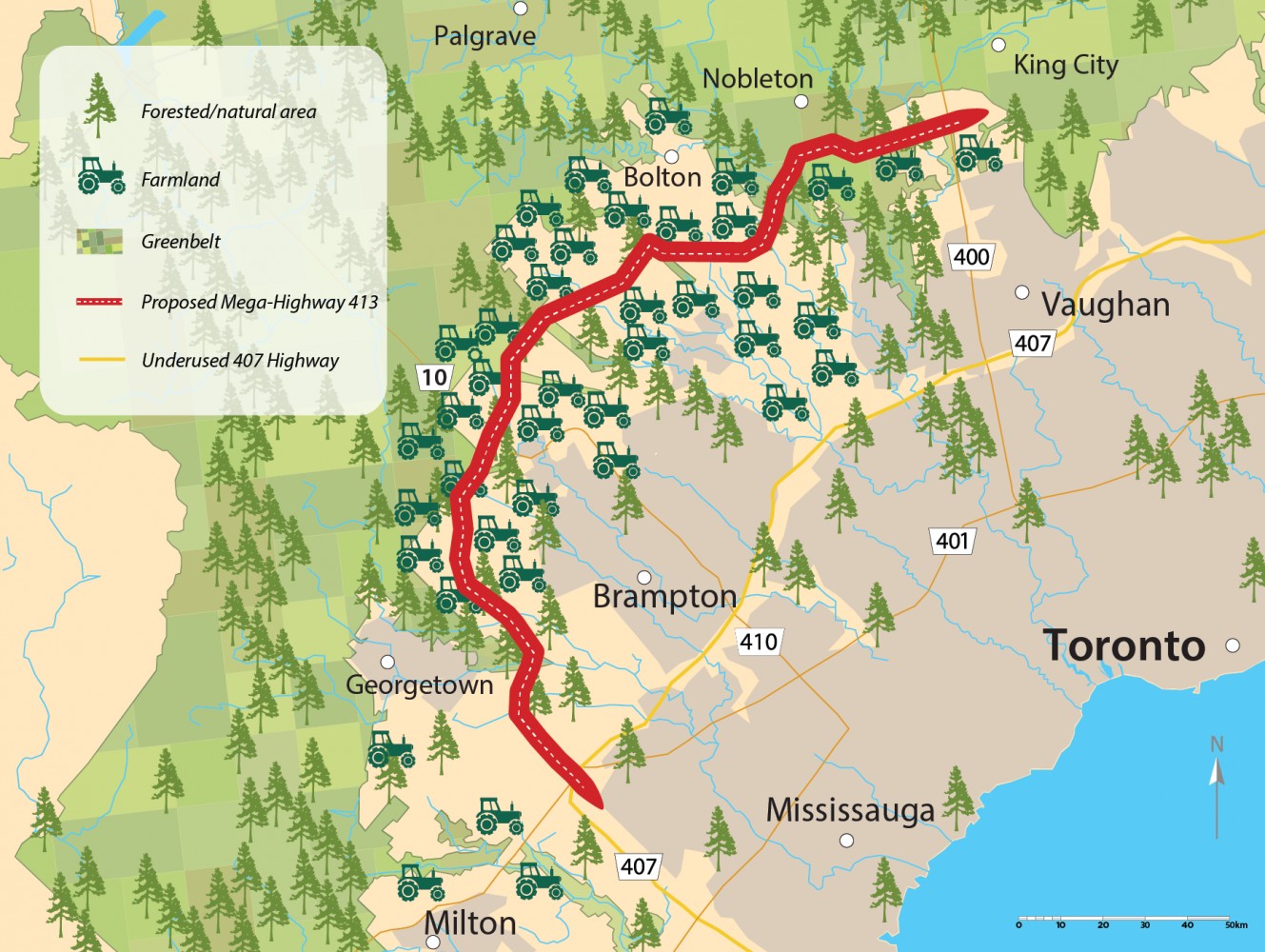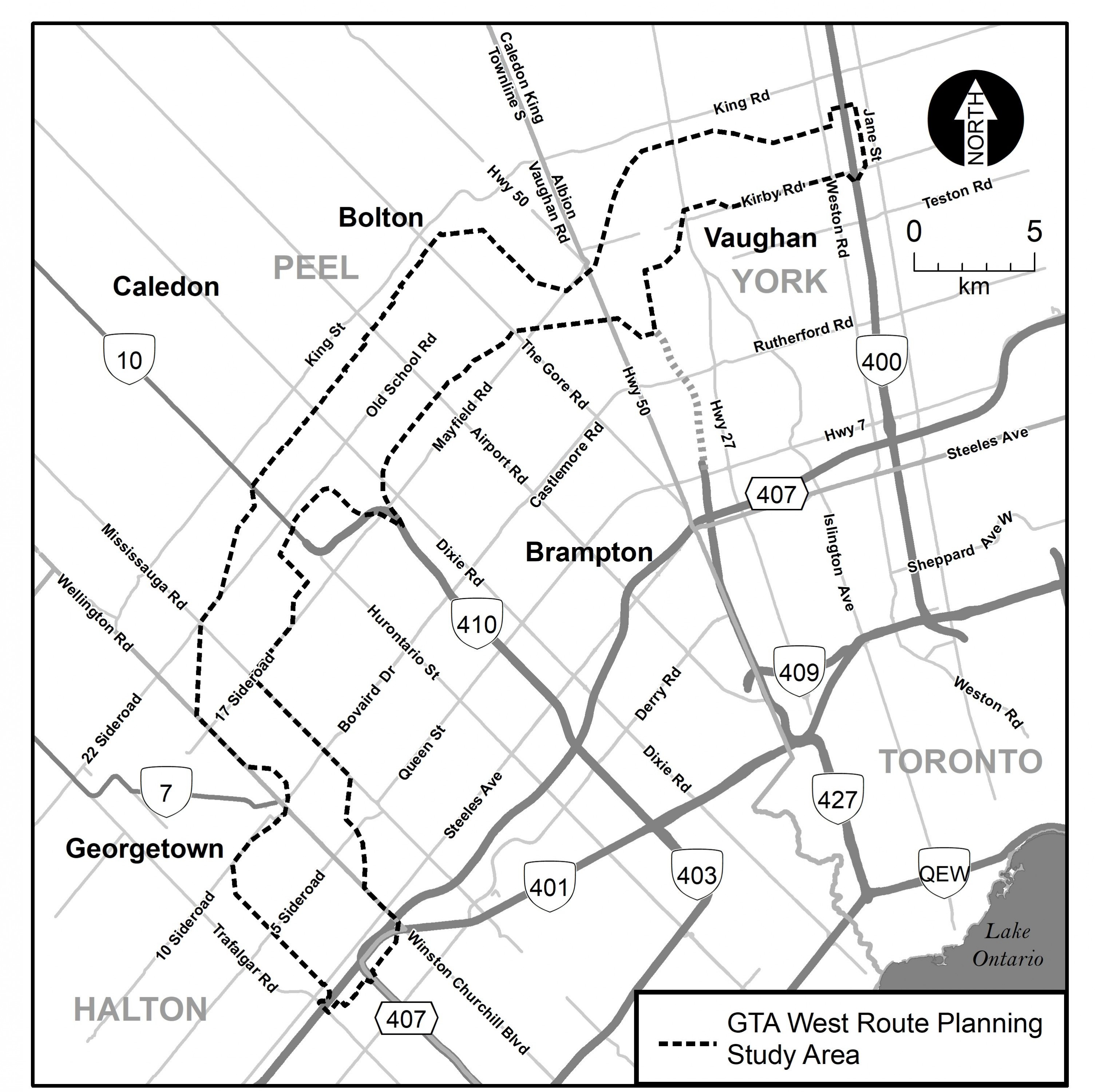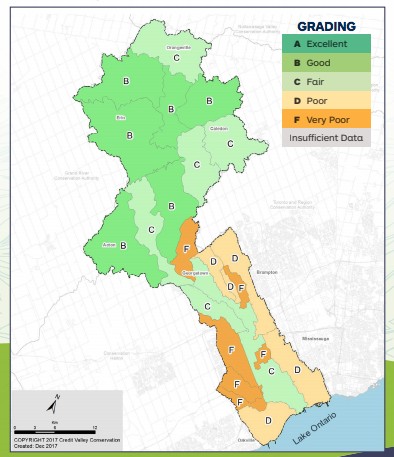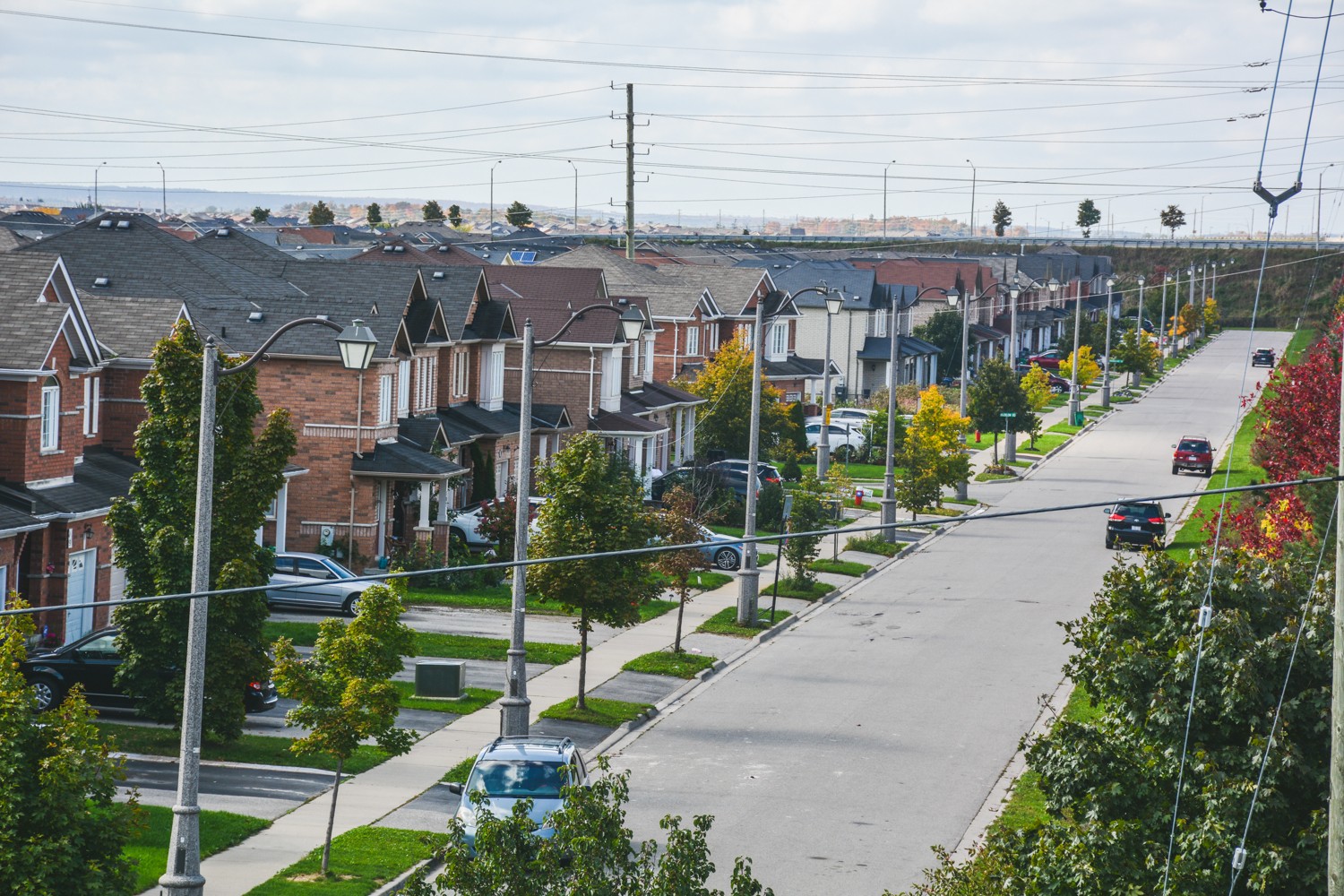
‘This is a government that would pave the Greenbelt’: Ford moves to ‘streamline’ environmental study for GTA West Highway
The Ontario government has announced plans to “streamline” the Environmental Assessment process for a new 400-series highway, which could see the controversial project break ground much earlier.
The GTA-West Corridor, or Highway 413, has sparked concern among local residents and environmental advocates since its inception. The disdain has been renewed with the province’s latest effort to speed the EA process along, despite expert analysis that advised the previous government to scrap the project because the entire corridor runs along major watersheds, much of the legally protected Greenbelt and would create devastating environmental impacts across the region.
In Wednesday’s post soliciting public comment on the proposal, the provincial government’s official announcement says its plans will “eliminate duplication while maintaining environmental protection”. The new process will prevent departments from doing the same work twice and remove elements of the process the PC government sees as hindering rather than helping, according to its claims.

The current study area for the GTA West Highway.
The page includes details around what elements will remain in the incredibly complex environmental assessment process for the major 4-series highway that, if built, would pass over much of the GTA. But few examples or details of the duplication ministries seek to remove are included in the brief document.
“The government is saying they want to streamline the environmental process; from where I sit, I am concerned it is steamrolling the process,” Jennifer French, NDP Opposition Critic for Infrastructure, Transportation and Highways, told The Pointer. “We know that this is a government that would pave the Greenbelt if we took our eyes off them.”
The planned highway will stretch from Milton to Vaughan, arcing up the western end of Brampton and then bending east through Caledon just above the border of the two municipalities. Its specific route has not been finalized, but the area sketched for construction skirts along the provincially protected Greenbelt, through the habitats of endangered species and will fragment a variety of sensitive watersheds.
In 2015, the Ontario Liberals put the brakes on the project, commissioning a full review of the highway’s impacts by a panel of experts. Three years later, in early 2018, the highway was scrapped altogether after the panel found few benefits and outlined a disproportionate impact on the environment.
“The EA did not demonstrate that a new corridor which crosses protected lands (both prime agricultural lands and key natural heritage and hydrologic features) was the only option available to address the study area’s future transportation needs,” the panel wrote, suggesting measures such as a congestion charge (or carbon pricing) would be significantly more effective. As for congestion-relief claims used by the PCs and local politicians such as Caledon Mayor Allan Thompson, one of the highway’s most aggressive supporters, the panel’s research found a savings of only 30 seconds will be achieved by travellers who use the highway instead of existing routes across its corridor.
After taking office, Ontario Premier Doug Ford reversed the decision to shelve it, restarting the process exactly where it stopped in 2015.
His move coincided with the release of a sweeping 2018 report by the Intergovernmental Panel on Climate Change, which included contributions by more than 6,000 international scientists. Their alarming research showed that one of the biggest contributors to devastating global temperature increase is poor land-use planning by local governments. It implored cities and regions to stop using land for sprawl and the creation of outdated highways that send huge amounts of pollution into the airshed, while creating more and more congestion.
Peel Regional Council declared a climate emergency on the same day it endorsed the PC government’s relaunched EA for the new highway, which the powerful developer lobby has aggressively pushed.
The possibility of streamlining the environmental assessment process is fraught with potential problems. These studies are completed in order to detail the potential issues and challenges of such a massive project, using a variety of measures and tests. They vary in detail and scope depending on the project, with more stringent and detailed studies completed for bigger plans. The process for a major highway can take years, measuring everything from air and sound quality impacts, effects on groundwater and local waterways, as well as traffic levels and the benefits to the province’s transportation network.

The GTA West Highway will run north of the Credit Valley Conservation (CVC) watershed, which already has several areas with poor or very poor surface water quality, something that will only be made worse by a highway running near the green northern reaches.
Other ecological tests have to be completed including impacts on local species, migration patterns, wetlands and potential encroachment on environmentally protected lands.
EAs are crucial measures of due diligence and ensure that residents, the environment and surrounding communities are not unfairly impacted by new developement.
Now, the Ministry of Environment, Conservation and Parks, alongside the Ministry of Transportation, is proposing the process be “streamlined” specifically for the controversial Highway 413.
Queen’s Park anticipates reducing the assessment time will allow the project to be constructed earlier, something the PCs argue is desperately needed to “ease congestion” on the GTA’s other 400 series highways. It’s a claim the panel of provincially appointed experts refuted in 2018, highlighting how the new 413 would effectively do nothing to help with existing traffic issues in and around Toronto, and would eventually make traffic worse while putting even more cars on roads. Further sprawl, which recent provincial legislation has specifically attempted to curb, will also be created as a result of the highway. Thompson himself sold family land along the corridor to subdivision developer Primont Homes, for $9.4 million.

The GTA West Highway, if constructed, will open up large swaths of land near the Greenbelt for sprawling suburban development.
If the streamlined EA is approved, the project’s preliminary design could be complete by 2022 rather than “2023 or beyond.”
“Through these sensible, practical changes, we are bringing Ontario’s environmental assessment program into the 21st century,” the proposal reads.
That’s not the view of Environmental Defence’s Programs Director, Keith Brooks.
“I think there are much better uses of taxpayer dollars than another 400-series highway that is going to do nothing to alleviate congestion, but will impact the Greenbelt, agricultural land, … endangered species habitats and crosses something like 50 different streams and rivers,” he told The Pointer. “It’s going to lead to more sprawl, more pollution and more cars.”
Brooks says that, with all eyes on COVID-19, the Progressive Conservatives are delivering a wishlist for developers and not residents. “Under the guise of economic recovery after COVID-19, they are putting the full pedal to the metal on their pro-sprawl agenda,” he said.
Ford’s links to the development industry are well documented. In the run up to his election in 2018, he was covertly recorded promising a room of development industry leaders that he would open up the protected Greenbelt to allow for the construction of new homes and subdivisions. Ford backed away from the comments when they were revealed, but critics say they show what his true intentions are.
The development industry’s interest in the GTA-West Corridor is equally well known.
In an opinion article published in several GTA newspapers in August 2018, Dave Wilkes, president and CEO of the Building Industry and Land Development Association (BILD), a very active lobby group for developers, wrote: “The GTA Corridor West was not just a proposed highway. It was a means to unlock both commercial and residential land for development.”
He lamented the cancellation of the highway by the previous Liberal government. “Something must be done to improve traffic congestion in our region.”
At the Region of Peel, some councillors share BILD’s view. In October, Jennifer Innis, a Caledon Councillor, expressed disappointment at how long the EA would take to complete. “Time is of the essence,” she said to her fellow councillors, linking the highway to the Town of Caledon’s Official Plan and the creation of new jobs.
The province promises the streamlined EA process would still include field investigations and technical information, public and stakeholder engagement, as well as dialogues with Indigenous communities. The PCs say all they plan to remove are antiquated policies that slow the process down.
Critics like Brooks argue EAs are exactly where careful due process is key. A methodical and scientific approach to understanding the geological, geographical, environmental and other impacts of a new multi-lane highway is critical to uncovering potential complications from construction.
“There’s multiple interchanges … they haven’t done the assessment of endangered species yet and all of these things,” Brooks added. “I don’t see how they can suggest that they’re protecting the environment while rushing through an Environmental Assessment.”
A decision this year by the Region of Peel demonstrates the complicated nature of EAs. Resident Rob Harrison twice presented to regional councillors, most recently in March, about a regional plan amendment (known as ROPA34) to greenlight further development in Caledon’s Mayfield West area, just above Brampton.
The Valleywood Residents Association, represented by Harrison, said the EA for the project was incomplete and did not capture the full picture. Harrison said the environmental investigation did not reflect the level of illegal and unregistered trucking taking place in the area and put his community in danger by removing an emergency vehicle priority lane from the only road in and out of the Valleywood subdivision. Following Harrison’s second presentation, and with additional concerns about population distribution, councillors voted to defer a decision on passing the amendment until at least the end of 2020.
Caledon resident Rob Harrison
In theory, the bureaucratic nature of environmental assessments is designed to investigate similar concerns or potential problems, avoiding the need to defer or even cancel projects once the research is complete.
“It isn’t just about making it faster, it’s about making it better,” MPP French added, raising concern about a section of the GTA-West EA proposal that suggests replacing the public consultation process with an issue resolution stage instead. “You don’t want to do the same things over and over, but you cannot leave out the planning stages. You cannot leave out the public stages.”

Oshawa MPP Jennifer French, the NDP Opposition Critic for Infrastructure, Transportation and Highways
Debbe Crandall, a Caledon resident and member of Save the Oak Ridges Moraine (STORM), lamented the plan in an interview with The Pointer. “It is not a simple road widening, it’s an extremely acute potential impact of a 400-series highway running through the southern part of Caledon. [It will] have phenomenal impacts,” she said.
Highlighting the effect the massive construction project could have on watersheds and protected areas, Crandall said she was mystified as to why the project was going ahead at all, let alone faster than before.
“To me it’s beyond comprehension that this will be going forward. To think that it is the highway that is the basis for long-term strategic planning for that part of Caledon; how absurd,” she added.
In a statement posted on the Environmental Defence’s website, Brooks criticized the government’s new COVID-19 Economic Recovery Act, of which the move to streamline EAs is a part, as an opportunistic ploy.
“This sweeping omnibus Bill appears to be a thinly veiled attempt to package up the development industry’s wish list and pass it off as a necessary response to the pandemic and the economic impacts it has caused,” he said. “The Bill would make substantive changes to the Environmental Assessment Act, most significantly to move from an approach where an Environmental Assessment is always needed unless an exemption is granted, to an approach where one is only needed for designated projects.”
It’s unclear why short-term economic advantages arising from current conditions would be considered over the potential decades-long harm that the project could create across the entire GTA, with more pollution, more cars and congestion, more sprawl, the attraction of more low-paying, low property-tax producing businesses linked to transportation and hardly any benefits.
The only industry that will almost certainly see advantages is the residential subdivision development sector, with many builders having already bought up land along the corridor, which will dramatically increase in value if they get to build more sprawl along a new highway.
The proposal to speed up the EA, a move sure to be welcomed by groups such as BILD, also makes reference to starting some construction activities early.
The proposed regulation would “permit early works to proceed to construction before the draft Environmental Impact Assessment Report,” subject to certain conditions. The early works listed include new bridge construction, bridge replacement and utility relocation.
A spokesperson for the Ministry of Transportation reasserted the proposal will continue to protect the environment and simply reduce the “administrative burden for transportation projects”.
“They also allow the province to prioritize critical infrastructure projects while ensuring environmental protections by setting out a new streamlined assessment process,” the government spokesperson said.
Email: [email protected]
Twitter: @isaaccallan
Tel: 647 561-4879
COVID-19 is impacting all Canadians. At a time when vital public information is needed by everyone, The Pointer has taken down our paywall on all stories relating to the pandemic and those of public interest to ensure every resident of Brampton and Mississauga has access to the facts. For those who are able, we encourage you to consider a subscription. This will help us report on important public interest issues the community needs to know about now more than ever. You can register for a 30-day free trial HERE. Thereafter, The Pointer will charge $10 a month and you can cancel any time right on the website. Thank you.
Submit a correction about this story


